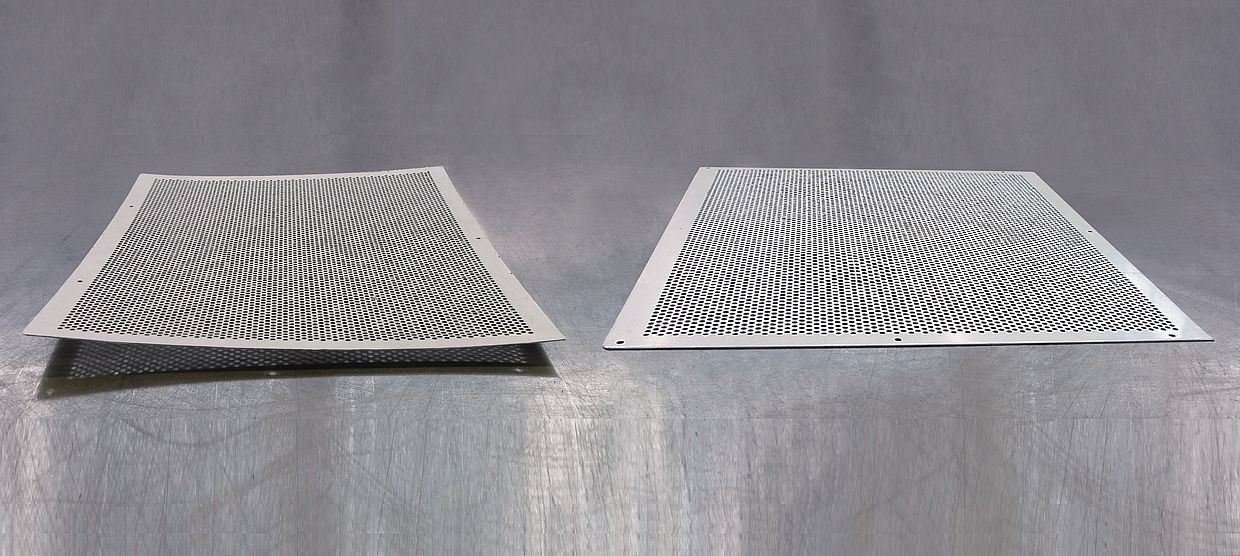Many industries, just like steel service centers and construction equipment manufacturers have discovered that flat parts, sheets/plates allow for increased downstream processing efficiency. Leading to reduced production costs and increased final product quality. All while reducing your lead times!
There are many conventional flattening methods which are still being used today. Here is a list of these most commonly used methods:
1. Hammer and flame
2. Press brake (straightening press)
3. Roll bender (simple rolling machine)
4. Simple roller leveler
5. Precision leveler
Hammer and flame
This method calls for heating the material up to a certain point so it becomes malleable enough to hammer it to the desired flatness. In retrospective, this completely disregards any kind of internal stress removal from the material. Instead, the internal stress is simply just pushed around the material, rather than being reduced. Additionally, this method also takes a very skilled operator. Even with a skilled operator, this procedure is still very time consuming and relatively slow. It is also a very physical and dangerous job as one second not paying attention, could get the employee seriously injured. All in all, it delivers inconsistent results which are all still high of internal stress.
Press brake (straightening press)
As we all know, most metal fabricators work with press brakes. These machines are mainly utilized to efficiently and accurately provide specific types of bends in the material. Some fabricators also use these machines to press their materials flat. In other words, they simply take their materials and use the press brake to push any kind of flatness deformations out of the material. This on the other hand is very time consuming, requires a skilled operator and can be dangerous as well. Most importantly, just like the hammer and flame method, it is inconsistent and disregards the reduction of internal stress completely.
Roll bender (simple rolling machine)
A simple roll bender can be found in many metal fabrication shops all around the globe. These machines mainly consist of 3 large rollers that are mounted in a staggered fashion. These rollers complete the metal flattening process by bending the material back and forth until it is in a flat state. It is actually regarded as the simplest form of a roller leveler. Just like the two previous methods above, this procedure is very time consuming, requires a skilled operator and at the end of the day, the results are still inconsistent and high of internal stress.
Overview of the most common leveling methods
Read our overview of the various leveling methods and find out which one is the ideal solution for you.
Simple roller leveler
Leveling materials with multiple rollers is a very common method. Roller leveling is part of the bending processes family. The material runs through a series of offset leveling rollers and gets flattened. Simple roller levelers, also referred to as straighteners, are generally built with a minimum of seven leveling rollers. The rollers are generally large in diameter and are spaced far apart. That is why they are more predominately designed to process very thick parts or plates. Consequently, these machines also lack the precision for many of today’s applications. One reason is that usually the leveling rollers are not supported to prevent deflection. This means that the rollers themselves bend due to the pressure of the material. Nevertheless, simple roller levelers can only provide certain flatness specifications and yet still need an expert to operate them. Additionally, the process needs to be repeated multiple times, which is very inefficient. All in all, since there are only a few bends being done to the material (none past the yield point), there is also close to no stress relive, which makes the material not suitable for efficient downstream processing. This results in additional reworking costs and a very unfavorable investment.
Precision leveler
Precision levelers process the material via a series of alternating bends. They can potentially have up to 21 rollers, which are all closely arranged in an offset pattern. All leveling rollers are supported by back-up blocks throughout the entire width and length of the rollers. This is done to avoid any deflection in the leveling rollers during the leveling process. The immense rigidity also provides highly precise leveling results which are unmatched in terms of flatness. Additionally, these levelers are also capable of reducing/removing the internal stress of the material. It can accomplish such, by bending the material pasts its yield point and then back into a flat state. These internal stresses in the material are created/released during cutting procedures such as via laser, plasma, oxyfuel or punching. Yet these stresses are not always immediately apparent. They might be easily visible in form of deformations right of the cutting or punching table in some cases. On the other hand, they might appear when the parts are being assembled (during welding for example, the heat releases the trapped inside stress in form of flatness deformations). These out of flat areas make it difficult to fit the parts into the welding fixtures. In addition, the stresses in the material can also result in inconsistent welds. This leads to extensive rework and in the worst case can render the parts unusable. Therefore by utilizing a precision leveler, you will receive the flatness and stress relieve needed for efficient downstream processing. All with the speed and consistency you require for optimal final product quality.
Summary
Many conventional metal flattening methods are still being used today. Nonetheless, these methods require specialists with extensive expertise and take a considerable amount of time. Precision levelers will alleviate the workload and increase efficiency and speed. This state-of-the-art approach to leveling also provides the tighter tolerances demanded by the industries today. Therefore allowing you to not only save money by reducing your costs, it also provides you with a competitive advantage thanks to the higher initial material quality.



